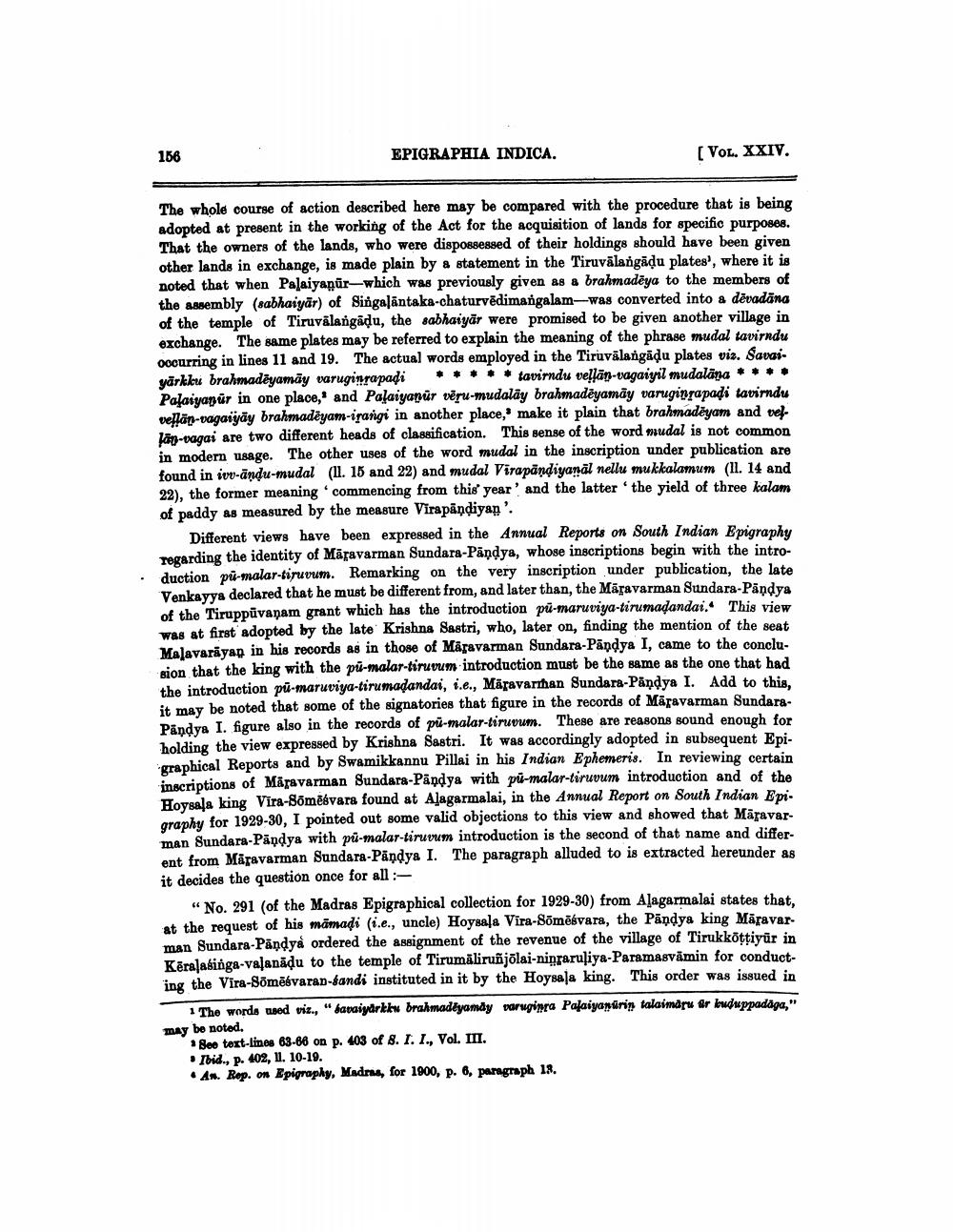________________
156
EPIGRAPHIA INDICA.
(VOL. XXIV.
The whole course of action described here may be compared with the procedure that is being adopted at present in the working of the Act for the acquisition of lands for specific purposes. That the owners of the lands, who were dispossessed of their holdings should have been given other lands in exchange, is made plain by a statement in the Tiruvālangāļu plates', where it is noted that when Palaiyaņūr—which was previously given as a brahmadēya to the members of the assembly (sabhaiyār) of Singaļāntaka-chaturvēdimangalam-was converted into a dēvadāna of the temple of Tiruvälangadu, the sabhaiyār were promised to be given another village in exchange. The same plates may be referred to explain the meaning of the phrase mudal tavirndu occurring in lines 11 and 19. The actual words employed in the Tiruvälangadu plates viz. Savai. yārklu brahmadēgamāy varuginrapadi .... tavirndu vellän-vagaiyil mudalana ... Palaiyanür in one place, and Palaiyanür vēru-mudalay brahmaděyamay varuginrapadi tavirndu veflän-vagaiyáy brahmadēyam-irangi in another place, make it plain that brahmaděyam and tel. län-vagai are two different heads of classification. This sense of the word mudal is not common in modern usage. The other uses of the word mudal in the inscription under publication are found in ivv-andu-mudal (11. 18 and 22) and mudal Virapandiyanál nellu mukkalamum (11. 14 and 22), the former meaning commencing from this year' and the latter the yield of three kalam of paddy as measured by the measure Virapandiyan'.
Different views have been expressed in the Annual Reports on South Indian Epigraphy regarding the identity of Māfavarman Sundara-Pāņdya, whose inscriptions begin with the intro• duction pi-malar-tiruvum. Remarking on the very inscription under publication, the late
Venkayya declared that he must be different from, and later than the Māravarman Sundara-Pāņdya of the Tiruppavanam grant which has the introduction pü-maruviya-tirumadandai.. This view was at first adopted by the late Krishna Sastri, who, later on, finding the mention of the seat Majavariyap in his records as in those of Māravarman Sundara-Pandya I, came to the conclusion that the king with the pu-malar-tiruvum introduction must be the same as the one that had the introduction pū-maruviya-tirumadandai, i.e., Märavarthan Sundara-Pandya I. Add to this. it may be noted that some of the signatories that figure in the records of Märavarman SundaraPandya I. figure also in the records of pü-malar-tiruvum. These are reasons sound enough for holding the view expressed by Krishna Sastri. It was accordingly adopted in subsequent Epigraphical Reports and by Swamikkannu Pillai in his Indian Ephemeris. In reviewing certain inscriptions of Märavarman Sundara-Pandya with pü-malar-tiruvum introduction and of the Hoysala king Vira-Somēbvara found at Alagarmalai, in the Annual Report on South Indian Epigraphy for 1929-30, I pointed out some valid objections to this view and showed that Māravarman Sundara-Pandya with pů-malar-tiruvum introduction is the second of that name and different from Märavarman Sundara-Pāņdya I. The paragraph alluded to is extracted hereunder as it decides the question once for all :
“No. 291 (of the Madras Epigraphical collection for 1929-30) from Alagarmalai states that, at the request of his mamadi (i.e., uncle) Hoysala Vira-Sõmēsvara, the Pandya king Māravarman Sundara-Pandya ordered the assignment of the revenue of the village of Tirukkottiyur in Kēralasinga-valanādu to the temple of Tirumāliruñjõlai-ninraruliya-Paramasvåmin for conducting the Vira-Somēbvarap-sandi instituted in it by the Hoysala king. This order was issued in
1 The words used viz., "bavaiyarkku brahmadiyamdy paruginea Palaiyapuriy talaimdu ar buduppadaga," may be noted.
Seo text-lines 63-68 on p. 403 of 8. I. I., Vol. II.
Ibid., p. 402, 11.10-19. • An. Rep. on Epigraphy, Madras, for 1900, p. 6, paragraph 18.




